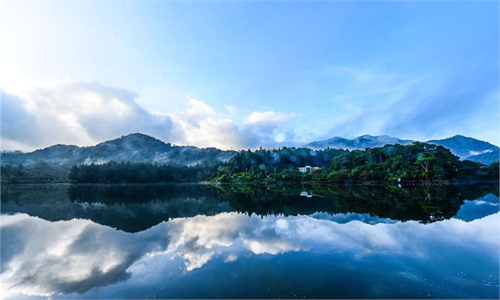
Aerial photo taken on February 13, 2021 shows the view of Yarlung Zangbo River and Medog county in Nyingchi of Southwest China's Tibet Autonomous Region. Photo: Xinhua
A Chinese political advisor suggested the country should accelerate building the Yarlung Tsangbo national park in the southeastern part of Southwest China's Tibet Autonomous Region, an action to further preserve the local ecosystem that features rich biodiversity.Building a national park in the lower reaches of the Yarlung Zangbo River and around its branches will be meaningful to protect the region of southeastern Tibet, resolve the contradiction between protection and development, promote national unity and maintain national security, Zhang Endi, a member of the National Committee of Chinese People's Political Consultative Conference (CPPCC) from Shanghai, said during the ongoing two sessions, the Global Times learned on Wednesday.
With the gradual improvement of transportation and infrastructure, as well as the ever-increasing demand for nature lovers, it is possible to develop an internationally influential experience "nature franchise," allowing local people to benefit from protection, said Zhang, who is also an expert in biodiversity.
According to Zhang, Yarlung Zangbo valley, 504.6 kilometers long with an elevation drop of more than 7,000 meters, is one of the top 34 biodiversity hotspots in the world. The valley is dubbed as a "Natural Vegetation Museum" because it is home to almost all terrestrial vegetation types from the tropics to the arctic zone, including some rare and even unique species.
It is also a habitat for many endangered animals, such as clouded leopards, snow leopards and red gorals. It is China's only confirmed habitat for Bengal tigers.
However, due to climate change and human activities, the ecosystem at the Yarlung Zangbo River faces threats and challenges.
The Tibet Autonomous Region has more than 60 regulations and laws involving environmental and ecological protection, according to a statement Tibet's delegation to the two sessions sent to the Global Times on Wednesday.
Around 45 percent of the area in the region is under protection within ecological "red lines." The region has built 47 natural reserves, accounting for more than 34 percent of the region's area, it said.
Moreover, Tibet has been turning woodcutters into forest rangers. Since 2016, more than 700,000 positions in environmental protection have been provided in the region.
Kunming, capital of Southwest China's Yunnan Province, which neighbors Tibet, will host the 15th meeting of the Conference of the Parties of the Convention on Biological Diversity in May.
If approved, the establishment of the Yarlung Tsangbo national park in Tibet will demonstrate China's resolution and endeavor to the whole world in preserving biodiversity, Zhang added.





